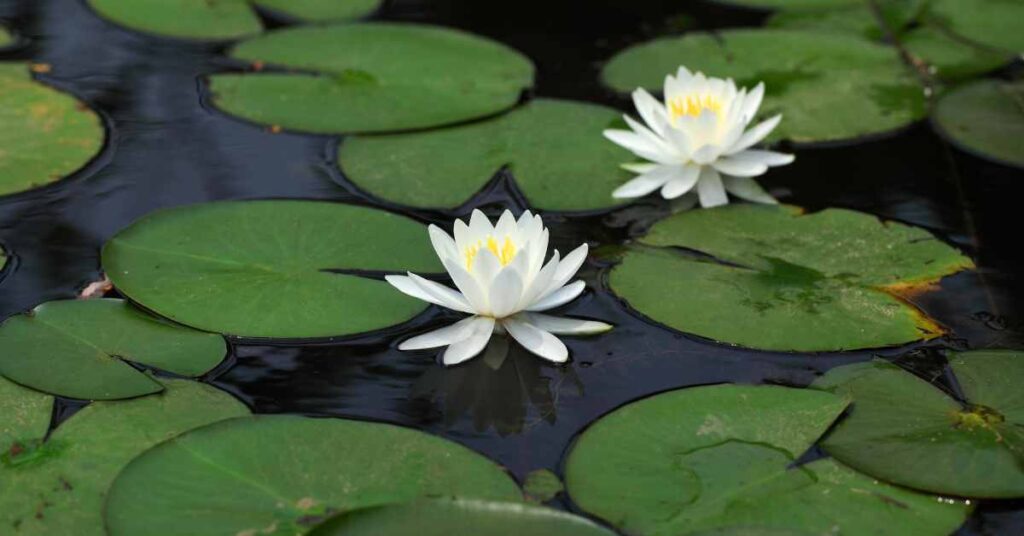Introduction to the White Lotus Flower
The white lotus flower (Nymphaea lotus) is a striking aquatic plant known for its beauty, cultural symbolism, and ecological significance. Found primarily in tropical regions of Asia and Africa, the white lotus has long been revered in various spiritual traditions, particularly in Buddhism and Hinduism. It is often associated with purity, enlightenment, and rebirth, owing to its ability to bloom in murky waters, rising above the mud to display its pristine white petals.
Beyond its cultural and symbolic importance, the white lotus flower plays a vital role in aquatic ecosystems, contributing to biodiversity, water quality, and habitat support for various species. This article delves into the environmental niche of the white lotus flower, examining its ecological contributions, threats it faces, and its importance in promoting sustainable ecosystems.
Characteristics of the White Lotus Flower
Botanical Description
The white lotus flower is a member of the family Nymphaeaceae, which consists of aquatic plants known as water lilies. Some key characteristics of the white lotus include:
- Leaves: The leaves of the white lotus are large, round, and float on the surface of the water. They can grow up to 60 cm (24 inches) in diameter.
- Flowers: The flower itself has a distinctive, multi-petaled structure with bright white petals. The center contains a vibrant yellow or gold pistil and stamens. The flowers can grow up to 30 cm (12 inches) in diameter.
- Rhizomes: The plant grows from rhizomes (underground stems), which anchor the plant to the sediment of ponds, lakes, and slow-moving rivers.
Habitat and Distribution
The white lotus flower thrives in still or slow-moving freshwater habitats, such as ponds, lakes, and wetlands. It prefers warm, tropical climates and is commonly found across regions of Southeast Asia, the Indian subcontinent, and parts of Africa.
The white lotus requires shallow waters to grow, with its leaves and flowers floating on the water’s surface, while its roots remain submerged. This dual habitat—both above and below the water—allows the plant to interact with various elements of the ecosystem, making it an important contributor to environmental health.
Ecological Importance of the White Lotus Flower
Supporting Aquatic Biodiversity
The white lotus flower is an integral part of many freshwater ecosystems, providing habitat and shelter for a range of aquatic species. The plant’s large leaves create shade on the surface of the water, helping to regulate water temperature and create microhabitats for fish, amphibians, and invertebrates.
- Fish: Small fish often take shelter beneath the leaves of the white lotus, where they can hide from predators. These shaded areas also provide a cooler environment, which is crucial for species that thrive in lower temperatures.
- Insects: Insects, particularly pollinators like bees and beetles, are attracted to the white lotus flower’s large blooms. These insects play a crucial role in pollinating the plant and supporting the reproductive cycle of the species.
- Birds and Amphibians: Birds and amphibians may also rely on the white lotus as a food source or nesting area. Some species of frogs, for example, may lay their eggs in the water near lotus plants, where the dense foliage provides protection from predators.
Contribution to Water Quality
One of the white lotus flower’s most significant environmental contributions is its role in improving water quality. Like many aquatic plants, the white lotus helps filter and purify the water in which it grows. The roots and rhizomes of the plant absorb excess nutrients, such as nitrogen and phosphorus, which can lead to harmful algal blooms if left unchecked.
By absorbing these nutrients, the white lotus helps maintain a balanced nutrient profile in the water, preventing eutrophication (a process where excessive nutrients cause a dense growth of plant life and the death of animal life due to lack of oxygen). This process not only benefits the aquatic organisms that depend on clean water but also supports the overall health of freshwater ecosystems.
White Lotus Flower in Traditional and Modern Medicine

Traditional Uses
For centuries, the white lotus flower has been used in traditional medicine across Asia and Africa. In many cultures, various parts of the plant, including the flower, seeds, and roots, have been used to treat a wide range of ailments.
- Roots and Rhizomes: The rhizomes of the white lotus are commonly used in traditional Chinese and Ayurvedic medicine. They are believed to have cooling properties and are often used to treat conditions such as diarrhea, inflammation, and fever.
- Seeds: The seeds of the white lotus are highly nutritious and are used in both culinary and medicinal applications. They are rich in protein, fiber, and essential vitamins, making them a popular health food. In traditional medicine, lotus seeds are often used to improve digestion, promote heart health, and support the immune system.
- Flowers: The petals of the white lotus are sometimes used in herbal teas and tonics, where they are thought to have calming and stress-relieving properties.
Modern Scientific Research
In recent years, modern science has begun to explore the potential health benefits of the white lotus flower. Some studies have suggested that the plant may possess antioxidant, anti-inflammatory, and antimicrobial properties, which could make it a valuable natural remedy for a variety of health conditions.
For example, research has shown that extracts from the white lotus flower may help reduce oxidative stress in the body, potentially lowering the risk of chronic diseases such as heart disease and cancer. Additionally, the plant’s anti-inflammatory properties may offer relief for conditions like arthritis and skin disorders.
Threats to the White Lotus Flower and Its Habitat Habitat Loss and Degradation
One of the greatest threats to the white lotus flower is the loss and degradation of its natural habitat. Wetlands, ponds, and other freshwater environments where the plant thrives are increasingly under pressure from human activities such as agriculture, urban development, and pollution.
- Agricultural Runoff: The use of chemical fertilizers and pesticides in agriculture can lead to nutrient runoff, which contaminates freshwater habitats. This can disrupt the delicate balance of nutrients in the water, leading to the growth of harmful algae and the decline of aquatic plant species like the white lotus.
- Urbanization: As cities and towns expand, natural wetlands and ponds are often drained or filled in to make way for buildings, roads, and other infrastructure. This destruction of habitat can result in the loss of biodiversity and the displacement of species that rely on the white lotus for shelter and food.
Climate Change
Climate change poses another significant threat to the white lotus flower and the ecosystems it supports. Rising temperatures, changes in precipitation patterns, and the increasing frequency of extreme weather events can all have detrimental effects on the plant’s growth and reproduction.
- Temperature Sensitivity: The white lotus flower thrives in warm, tropical climates, but extreme heat can stress the plant and reduce its ability to bloom. Similarly, unusually cold temperatures can damage the plant’s delicate leaves and flowers.
- Water Availability: Changes in rainfall patterns can affect the availability of freshwater habitats for the white lotus. Droughts, for example, can cause ponds and wetlands to dry up, while heavy rainfall and flooding can lead to the erosion of riverbanks and the destruction of aquatic plants.
Conservation and Restoration of White Lotus Habitats
Wetland Conservation Efforts
Conserving and restoring wetlands is essential to protecting the white lotus flower and the biodiversity it supports. Wetlands are one of the most productive ecosystems on Earth, providing critical habitat for countless species and playing a vital role in regulating water quality and carbon storage.
Several organizations and governments are working to conserve and restore wetlands through initiatives such as:
- Protected Areas: Establishing protected areas that safeguard wetlands from development and pollution is one of the most effective ways to conserve white lotus habitats. These protected areas can also serve as refuges for other endangered species.
- Wetland Restoration Projects: In regions where wetlands have been degraded or destroyed, restoration projects aim to bring these ecosystems back to life. These projects often involve reintroducing native plant species, including the white lotus, and restoring the natural hydrology of the area.
Promoting Sustainable Agriculture and Water Management
Sustainable agriculture practices and responsible water management are critical to reducing the environmental impacts on freshwater habitats and the white lotus flower. These practices include:
- Reducing Chemical Use: Limiting the use of chemical fertilizers and pesticides can help prevent nutrient runoff into freshwater habitats, protecting the white lotus and other aquatic species.
- Implementing Buffer Zones: Creating buffer zones of native vegetation around ponds, lakes, and wetlands can help filter pollutants and reduce the impact of agriculture and urbanization on freshwater ecosystems.
- Water Conservation: Encouraging responsible water use and conservation can help ensure that enough freshwater is available to support aquatic plants like the white lotus, especially in regions affected by drought or water scarcity.
Cultural and Spiritual Significance of the White Lotus Flower

Symbolism in Buddhism and Hinduism
The white lotus flower holds deep spiritual significance in several Eastern religions, particularly in Buddhism and Hinduism. In both traditions, the white lotus is a symbol of purity, enlightenment, and spiritual awakening.
- Buddhism: In Buddhist teachings, the lotus flower represents the journey toward enlightenment. Just as the lotus rises from the mud and blooms in pristine beauty, individuals can rise above the difficulties and suffering of life to achieve spiritual awakening. The white lotus, in particular, symbolizes purity of mind and spirit.
- Hinduism: In Hinduism, the white lotus is associated with several deities, including Lakshmi, the goddess of wealth and prosperity, and Saraswati, the goddess of knowledge and wisdom. The flower is often depicted as a symbol of divine beauty and purity.
The Lotus in Art and Literature
The white lotus flower has also been a prominent motif in art and literature throughout history. Its beauty and symbolism have inspired artists, poets, and writers across cultures, from ancient religious texts to modern works of art.
- Ancient Texts: In ancient religious texts, such as the Bhagavad Gita and Buddhist sutras, the white lotus is often used as a metaphor for spiritual purity and transcendence.
- Art and Sculpture: The white lotus has been a popular subject in traditional art forms, including paintings, sculptures, and architecture. In many temples and religious sites across Asia, the lotus flower is depicted in intricate carvings and murals.
Conclusion
The white lotus flower is not only a symbol of purity and spiritual awakening but also a vital component of freshwater ecosystems. Its ecological contributions, including supporting biodiversity, improving water quality, and providing habitat for various species, make it an essential plant in maintaining environmental balance.
However, the white lotus faces significant threats from habitat loss, climate change, and pollution. Conservation efforts, such as wetland protection and sustainable agriculture practices, are crucial in safeguarding this iconic plant and the ecosystems it supports.
As we continue to explore and understand the importance of the white lotus flower in both spiritual and environmental contexts, it becomes clear that this remarkable plant holds the key to not only enriching our cultural heritage but also preserving the health of our planet’s freshwater ecosystems.
Read More: Teaberry: The Small Berry with Big Environmental Impact

